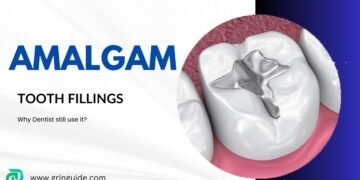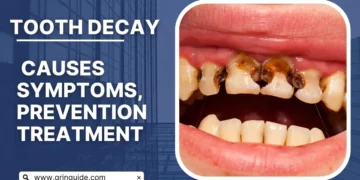Table of Contents
Introduction to Tooth Fillings
Tooth fillings are a common dental procedure designed to restore the integrity and functionality of a tooth that has been compromised by decay or damage. The primary purpose of a tooth filling is to repair cavities, which are small holes in the teeth caused by bacterial infection. When left untreated, cavities can lead to severe dental issues, including tooth decay, pain, and even tooth loss. Thus, timely intervention with a filling is crucial for maintaining oral health.
There are various materials used for fillings, each with its own advantages and suitability depending on the specific dental needs of the patient. Common types include composite resins, amalgam, gold, and porcelain. Composite resins, often referred to as white fillings, are popular for their aesthetic appeal as they blend seamlessly with the natural color of the teeth. Amalgam, on the other hand, is known for its durability and strength, making it a preferred choice for fillings in the back teeth where chewing forces are greatest.
The need for tooth fillings arises primarily from cavities, but they are also necessary for repairing cracked or broken teeth, and teeth that have been worn down from habits such as grinding or nail-biting. A dental filling not only restores the tooth’s structure but also prevents further decay by sealing off spaces where bacteria can enter. This is essential for maintaining good oral hygiene and overall dental health.
Understanding the role and importance of tooth fillings is the first step in preventing more serious dental complications. By addressing cavities and other forms of tooth damage promptly, fillings help in preserving the natural function and appearance of your teeth, contributing to a healthier and more confident smile.
Types of Tooth Fillings
When it comes to dental restorations, several types of materials can be used for tooth fillings, each with its own set of advantages and disadvantages. Understanding these options can help individuals make informed decisions about their dental care.
- Amalgam Fillings: Amalgam, often referred to as silver fillings, is one of the most well-known materials used for tooth fillings. It is composed of a mixture of metals, including silver, mercury, tin, and copper. Amalgam fillings are highly durable and can withstand significant chewing forces, making them ideal for molars at the back of the mouth. However, their metallic color makes them more noticeable, which can be a drawback for some patients.
- Composite Resin Fillings: Composite resin fillings are made from a plastic and glass mixture, allowing them to be closely matched to the natural color of teeth. This makes them a popular choice for fillings in visible areas. They bond directly to the tooth structure, providing support and reducing the risk of further decay. While aesthetically pleasing, composite resin fillings are less durable than amalgam and may require more frequent replacement.
- Gold Fillings: Gold fillings are renowned for their durability and longevity, often lasting over 20 years. They are custom-made in a laboratory and then cemented into place. Gold fillings do not corrode and can withstand heavy chewing forces. However, their cost is significantly higher than other materials, and their noticeable color may not appeal to everyone.
- Porcelain Fillings: Also known as inlays or onlays, porcelain fillings are custom-made to fit the tooth and are bonded in place. They are highly resistant to staining and can be color-matched to the natural tooth. Porcelain fillings are both strong and aesthetically pleasing, but they tend to be more expensive than other options and may require more than one dental visit to place.
- Glass Ionomer Fillings: Glass ionomer fillings are made from a mixture of glass and acrylic. They release fluoride, which can help protect the tooth from further decay. These fillings bond well to teeth and are often used for fillings in areas that are not subjected to heavy chewing pressure, such as around the gum line or for children’s teeth. However, they are generally less durable and wear-resistant compared to other materials.

By understanding the various types of tooth fillings available, patients can better discuss their options with their dentist and choose the most suitable material for their specific dental needs.
The Tooth Filling Procedure
The tooth filling procedure begins with an initial examination and diagnosis by a dental professional. During the initial visit, the dentist will assess the patient’s dental health, possibly using X-rays to identify the extent of decay or damage. This thorough examination ensures that a tooth filling is indeed the appropriate treatment option.
Once the need for a tooth filling is confirmed, the actual procedure can commence. The first step involves administering anesthesia to numb the affected area. Local anesthesia is typically used to ensure that the patient experiences minimal discomfort during the procedure. The dentist may also discuss the type of filling material that will be used, such as amalgam, composite resin, gold, or porcelain, depending on the patient’s needs and preferences.
After numbing the site, the dentist will proceed by removing the decayed portion of the tooth. This step is usually performed using a dental drill or laser. The goal is to eliminate any decay and prepare the tooth for the filling. Once the decay is completely removed, the dentist will clean the cavity to ensure it is free from bacteria and debris.
Next, the dentist will place the filling material into the cleaned cavity. If a composite resin is used, it will be applied in layers, with each layer being hardened using a special light. This layering process helps to achieve a strong and durable filling. For materials like amalgam or gold, the dentist will carefully shape and polish the filling to match the natural contours of the tooth.
The final steps involve checking the patient’s bite to ensure that the filling does not interfere with normal chewing. The dentist may make necessary adjustments to the filling to ensure a comfortable fit. The entire tooth filling procedure usually takes about an hour, though this may vary based on the complexity of the case and the materials used.
Throughout the procedure, patients can expect clear communication from their dentist, who will explain each step and ensure that they are comfortable. Understanding the tooth filling process can help alleviate any anxiety and ensure a smooth, stress-free dental experience.
Post-Procedure Care
Proper post-procedure care is crucial to ensure the longevity and success of a tooth filling. After receiving a filling, maintaining optimal oral hygiene practices is essential. Begin by gently brushing your teeth twice daily with a fluoride toothpaste, ensuring you clean around the filled tooth without applying excessive pressure. Flossing daily is equally important, as it helps remove food particles and plaque from areas that your toothbrush cannot reach, thereby preventing further decay.
Immediately following the procedure, you may experience some discomfort or sensitivity in the filled tooth. It’s advisable to avoid hot and cold foods and beverages, as these can exacerbate sensitivity. Stick to lukewarm or room temperature foods and drinks until the sensitivity subsides. Additionally, steer clear of hard, sticky, or chewy foods that could dislodge the filling or cause undue stress on the treated tooth. Examples of such foods include candy, nuts, and gum.
If you experience any discomfort, over-the-counter pain relievers like ibuprofen or acetaminophen can help manage the pain. However, if the discomfort persists beyond a few days, or if you notice any signs of infection such as swelling, pus, or increased pain, it is imperative to contact your dentist promptly for an evaluation. Your dentist might recommend a desensitizing toothpaste if sensitivity continues to be an issue.
Regular dental check-ups are vital in maintaining the health of your fillings and overall oral health. During these visits, your dentist will inspect the filled tooth to ensure it remains intact and free from decay. Following these guidelines will not only aid in the immediate recovery post-filling but also contribute to long-term dental health.
Potential Complications and How to Address Them
Tooth fillings, while generally effective, can sometimes lead to complications that necessitate additional attention and care. One common issue is allergic reactions to the materials used in the filling. Patients may experience symptoms such as itching, rash, or swelling around the site. It is crucial to inform your dentist of any known allergies prior to the procedure to reduce this risk. If an allergic reaction occurs, immediate consultation with your dentist is advised to determine the next steps, which might involve replacing the filling with a different material.
Sensitivity is another frequently reported complication. Post-procedure, some individuals might experience heightened sensitivity to hot, cold, or sweet stimuli. This sensitivity often diminishes over time, but if it persists, there could be an underlying issue such as an improper fit of the filling or further decay. Desensitizing toothpaste or fluoride treatments can offer temporary relief, but persistent sensitivity warrants a visit to your dentist for a comprehensive evaluation.
Structural issues with the filling itself can also arise. Fillings may crack, chip, or even fall out due to various factors, including biting down on hard foods or the natural wear and tear over time. These incidents can compromise the integrity of the tooth, leading to pain or infection. If a filling becomes damaged or dislodged, it is imperative to contact your dentist promptly to have it repaired or replaced.
In some cases, patients may experience discomfort or a sense of uneven bite post-filling. This can be due to the filling being too high. A simple adjustment by your dentist can resolve this issue, restoring comfort and functionality to your bite.
Recognizing and addressing these complications timely is essential for maintaining oral health. Regular dental check-ups are instrumental in ensuring that any issues with tooth fillings are detected and managed promptly, thereby preventing more severe dental problems.
Cost of Tooth Fillings
The cost of tooth fillings can vary widely, influenced by several factors including the type of material used, the location of the filling, and whether dental insurance is available to offset some of the expenses. Understanding these variables can help patients make informed decisions about their dental care.
One of the primary determinants of the cost is the material chosen for the filling. Common materials include amalgam, composite resin, gold, and porcelain. Amalgam fillings, also known as silver fillings, are typically the least expensive option, ranging from $50 to $150 per tooth. Composite resin fillings, which are tooth-colored and blend seamlessly with natural teeth, cost between $90 and $250 per tooth. Gold fillings are more durable but can be quite costly, often ranging from $250 to $4,500 per tooth. Porcelain fillings, also known as inlays or onlays, are similar in cost to gold fillings, ranging from $300 to $4,500 per tooth.
The location of the tooth filling also impacts the overall cost. Fillings for front teeth may be less expensive because they are easier to access and typically require less material. Conversely, fillings for molars, which are harder to reach and may require more extensive work, can be more costly.
Dental insurance can significantly affect out-of-pocket costs for tooth fillings. Many insurance plans cover a portion of the cost, especially if the filling is deemed medically necessary. Typically, insurance will cover 50% to 80% of the cost of amalgam and composite resin fillings. However, coverage for gold and porcelain fillings may be more limited, often considered as elective or cosmetic procedures.
Additional factors that can influence the cost include the dentist’s experience, the location of the dental practice, and any additional procedures that may be required, such as X-rays or anesthesia. Patients are encouraged to discuss all these elements with their dentist to get an accurate estimate and explore the most cost-effective options for their specific needs.
Alternatives to Tooth Fillings
While tooth fillings are a common and effective solution for treating cavities and minor tooth decay, there are alternative treatments that may be more suitable depending on the specific dental situation. These alternatives offer various advantages and can be tailored to individual patient needs.
Crowns are often recommended when a tooth is significantly decayed or weakened. Unlike fillings that cover only a portion of the tooth, crowns encase the entire tooth, providing superior strength and durability. Crowns are particularly useful for teeth that have undergone root canals or have large fillings that are deteriorating. They help restore both function and aesthetics.
Inlays and onlays are another alternative to traditional tooth fillings. These are custom-made restorations that fit into or onto the tooth. Inlays are used when the damage is within the cusps of the tooth, while onlays cover one or more cusps. Made from materials like porcelain or composite resin, inlays and onlays offer a more conservative treatment approach by preserving more of the natural tooth structure compared to crowns. They are ideal for moderate decay where a filling may not be sufficient, but a crown is too extensive.
Fluoride treatments can be a non-invasive alternative for early-stage tooth decay. Fluoride helps remineralize the enamel, making it more resistant to acid attacks from bacteria. This treatment is particularly effective for patients with minor decay or those who are at high risk for developing cavities. Regular fluoride applications can prevent the need for more invasive procedures like fillings or crowns.
Choosing the right treatment depends on various factors, including the extent of decay, the location of the affected tooth, and the patient’s overall dental health. Consulting with a dental professional is crucial to determine the most appropriate course of action tailored to individual needs.
Frequently Asked Questions About Tooth Fillings
Tooth fillings are a common dental procedure, but patients often have several questions regarding their longevity, safety, and maintenance. Here, we address some of the most frequently asked questions to help you feel more informed about your dental care.
-
How long do tooth fillings last?
The lifespan of a tooth filling can vary based on the material used and the individual’s oral hygiene. On average, amalgam fillings can last between 10 to 15 years, while composite fillings may last between 5 to 10 years. Regular dental check-ups and good oral hygiene practices can significantly extend the longevity of your fillings.
-
Can I get a filling while pregnant?
Yes, it is generally safe to get a tooth filling while pregnant, particularly in the second trimester. However, it is important to inform your dentist about your pregnancy so they can take appropriate precautions. Non-urgent procedures might be postponed until after the birth to minimize any potential risks, but necessary treatments such as fillings can be safely performed to prevent complications from untreated dental issues.
-
How do I know if my filling needs to be replaced?
There are several signs that a tooth filling may need to be replaced. These include sensitivity to hot or cold foods, visible cracks or wear in the filling, or pain when biting down. Your dentist can identify these issues during a routine examination. It is important to address any concerns with your dentist promptly to avoid further dental problems.
By understanding the basics of tooth fillings, including their lifespan, safety during pregnancy, and signs of wear, you can take more informed steps in managing your dental health. Regular dental visits and good oral hygiene are key to ensuring the durability and effectiveness of your fillings.









